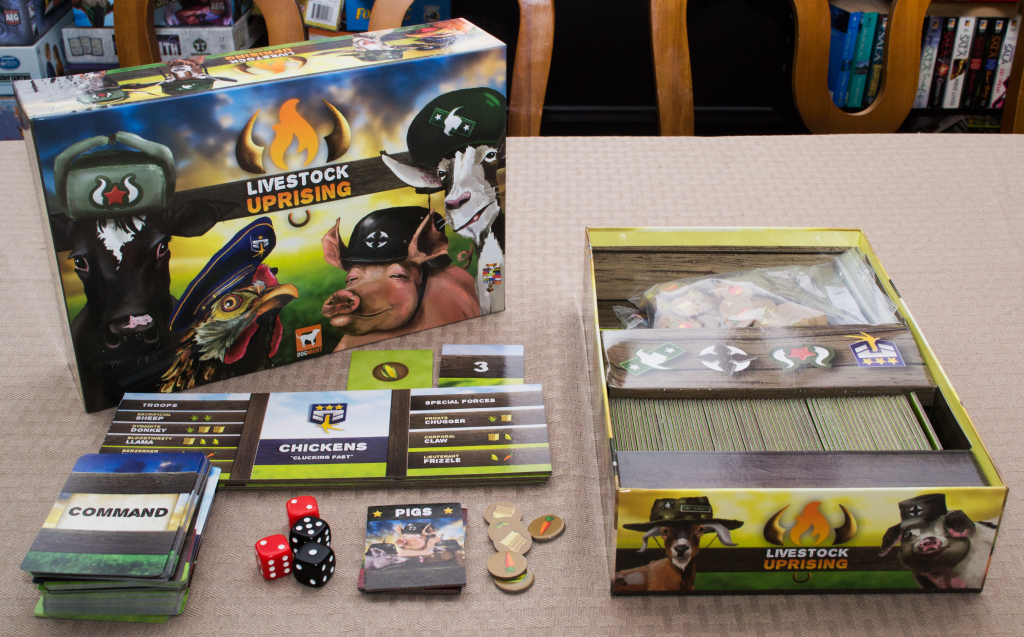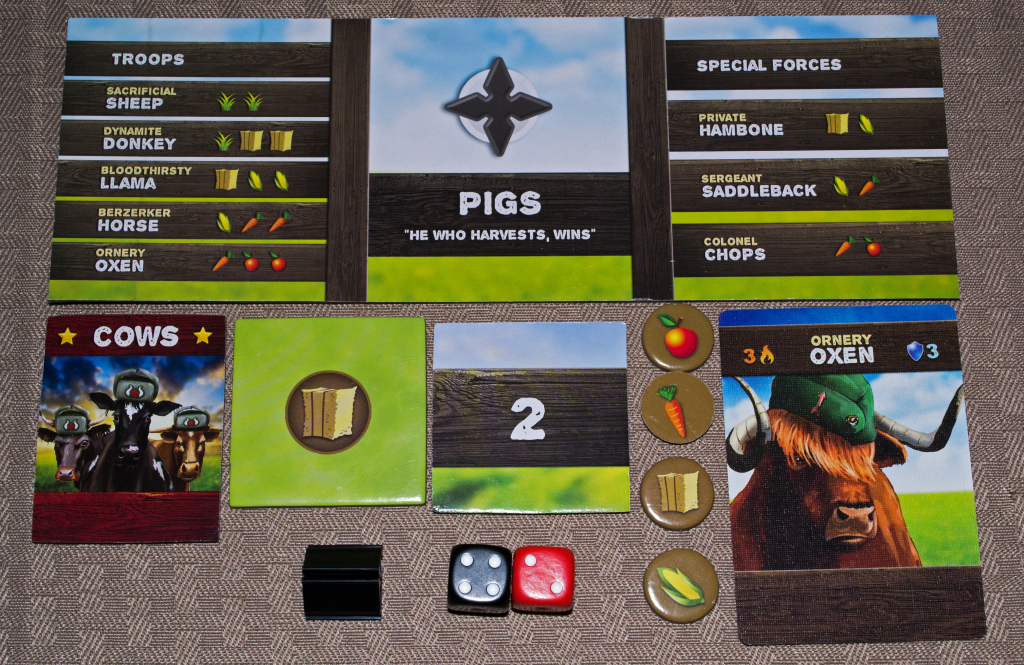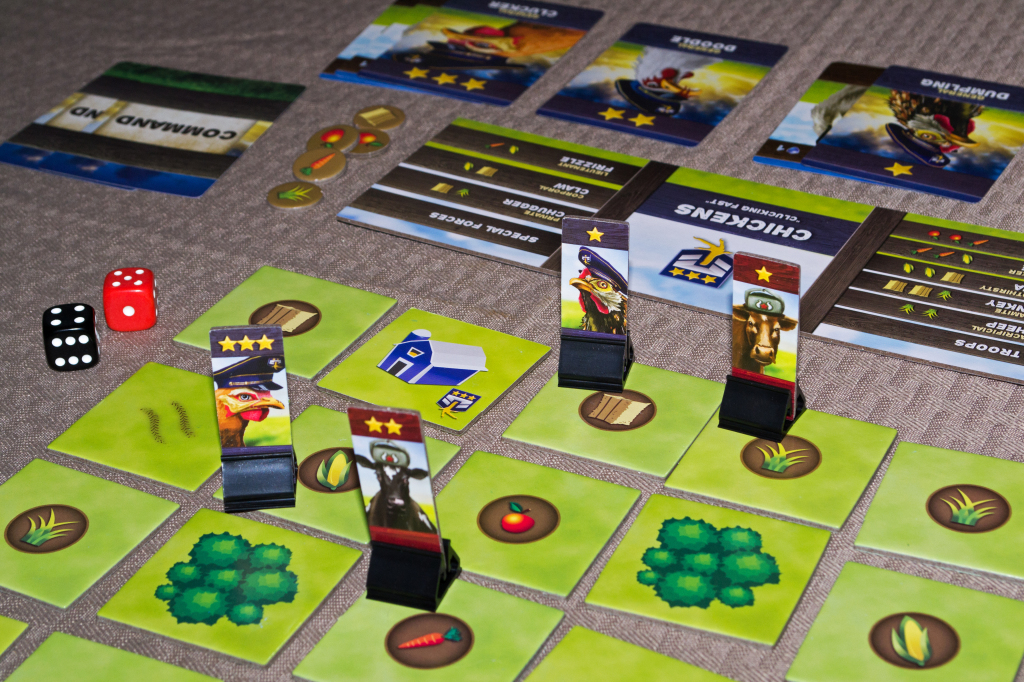I don’t know about you, but I’ve always wanted to lead armies of livestock against people that I didn’t like. Some might argue that there are more effective & non-violent methods for dealing with such people, but nothing says “in your face” more than letting a herd of cows run rampant on someone’s property. The smell from the droppings alone would almost certainly guarantee that the victim in question would have a rather crappy day (ba dump ch!). Thank you, thank you…no autographs please! At any rate, we’re here today to take a look at “Livestock Uprising”, a strategy/war game that involves…you guessed it, livestock. Don’t worry, there’s no manure involved. Rather, you’ll be collecting resources and recruiting livestock in an attempt to create a “super army” and wipe out all who oppose you. Before we get started, I’d like to thank Game Designer Mike Cameron from Dog Might Games for reaching out and providing me with a free press copy.
Components
Cards – The game includes a number of different card types, including: General Cards, Troop Cards, Special Forces Cards, Command Cards, and Battle Plans Cards. The first three card types will assist you in keeping track of where you armies currently reside while the last two card types act a bit like “action cards”.
Board Tiles – These sixty-four board tiles list varying symbols. Some tiles show a corn or carrot symbol, for example, which indicates that it provides a resource. Other tiles might show a lake or barn, representing terrain type or a player’s base, respectively.
Tokens – There are a number of resource tokens which match the symbols found on the resource tiles. You’ll also find “General Tokens” and “Super Army Tokens”…more on that later.
Faction Boards – There are four faction boards, representing the four different armies in the game: Chickens (blue), Cows (red), Goats (green), and Pigs (black).
Dice – Dice are mainly used to resolve combat.
Setup & Gameplay
Each player chooses a faction and receives the corresponding faction board, tokens, and cards. Each faction should have three general tokens, three general cards, three special forces cards, and one super army token. The command cards are shuffled with three being dealt to each player…the rest are discarded. A player’s hand will consist of the special forces and command cards, with the general cards being laid out for all to see. The board is set up differently depending on how many people are playing, but suffice it to say that you’ll have a square playing grid (player barns included) when you’re done. The general tokens are then placed on their corresponding barns. A die roll determines who goes first.
A player’s turn consists of three phases:
1. Action Phase: A player may move or attack with each of their generals, in any order. Certain movement rules apply. When attacking, the players will total the number of orange attack numbers and blue defense numbers listed on all of the cards involved. A single die is rolled on both sides to add to the players’ attack & defense values. If the attacker has a higher value, the defender must discard a troop or special forces card under their defending general and retreats to an empty adjacent tile. If the defender has the higher value, the attacker suffers a casualty instead. Nothing happens in case of a tie. Special forces cards, when lost, are permanently removed from the game.
2. Harvest Phase: A player may harvest resources on tiles occupied by their generals, assuming they have the ability to do so. In order to successfully harvest a resource, a general must have a troop card capable of harvesting said resource type. Grass is the only resource a general can harvest on their own. Assuming they can collect a resource, the player will receive a resource token of that type, though each general may only harvest a maximum of one resource per turn.
3. Marshaling Phase: A player may spend their resources to marshal/recruit new units for their generals. The cost of a troop card is listed on said card. A general may have no more than five units and can transfer a single unit to another general should they so desire.
Once a player’s turn is over, play will proceed clockwise. Over the course of the game, players may decide to form a “super army”. To do that, all of their generals must be on their barn space and combine into a giant, single unit. There are some rules associated with this, but suffice it to say that super armies can attack units inside enemy barns while regular generals cannot. Super armies also “eliminate” enemy generals, removing them from the game. On the downside, super armies cannot harvest resources. The player left standing at the end of the game, wins!
The above doesn’t cover all of the rules found in the manual, but should give you an idea as to how the game is played. The entire rulebook can be found here:
http://livestockuprising.com/docs/Livestock_Uprising_Rulebook_v1.0.pdf
The Review
First off, I have to say they I really enjoyed the theme. I mean, c’mon…”General Black Angus”. How many games do you know of that lets you command a general named “Black Angus”? The components were of good quality and I didn’t have a lot of trouble understanding the rules, despite the fact that the PDF manual is sixteen pages long. I admit that I was initially skeptical when I was asked to review this game, mainly due to its average play time (1.5-2 hours) and the size of the rulebook. I am pleased to report that the game isn’t all that complicated…it just takes a while for players to collect resources and form an army large enough to warrant a “super army” transformation.
Speaking of which, there’s quite a bit of strategy involved with the “super army” mechanic alone. While it seems like a good idea to turn your army into “The Borg” (watch your “Star Trek” kids), you may have good reason to hold off on doing so for a while. As far as I can tell, there is no “undo” button. This wouldn’t be so bad if you could continue to harvest resources and marshal forces after the fact, but you can’t. If your opponents manage to evade your super army and continue to collect and recruit, you could find yourself outmatched when they decide to form a super army of their own. As such, player’s will need to have good judgement when it comes to “timing” their actions.
I liked the fact that the special forces cards were unique to their faction (the standard troop cards are available to all factions). While they didn’t have special abilities per se’, they were often more powerful than the standard units. “T-Bone”, for example, provides a cow general five whole defense points (though he has no attack value). Standard units can be recruited again after death whereas special forces units are permanently removed from the game, so there is some sense of panic to be had. Admittedly, most of the adrenaline rushes occurred when super armies were formed. The command cards helped to mix things up before this occurred, though there’s no denying that the battle plans cards (drawn when super armies are formed) are beastly indeed.
My only point of concern was the price tag. Currently, the game is $39.95 (on sale from $44.95 during Fall Harvest) through the official website (linked below). As I’ve stated before in other reviews, I cannot claim to be familiar with development/manufacturing costs and the like as I myself have never ventured into that particular realm. With that said, I was discouraged to see that a number of additional items (mainly cosmetic in nature) were available at varying costs. Granted, you don’t need to buy any of it to experience the full glory of the base game, but the list of additional purchase options available make me wonder how much of it COULD have been packaged in the base game at no cost to the consumer. The coin trough & different colored faction dice, for example, don’t seem to warrant their own separate product (especially in the case of the latter). To be fair, the coin trough didn’t fit in the box in conjunction with the other components and box insert (I tried). On the plus side, I was happy to see a print and play version available for only $4.95…a great value all things considered.
In the end, “Livestock Uprising” turned out to be a joy to play despite my initial reservations. It’s relatively simple, yet it possesses all of the traits required to fall under the “war game” category. Combat, territory control, squad building, factions…it’s all there. Better yet, they’re all surrounded by a light-hearted theme that even grandparents and grandkids can get behind. I would have liked to have seen suggestions or variants to make the game shorter as it takes a while to harvest and build up forces. Perhaps if both sides started with a balanced set of fully loaded generals, eliminating the time it would take to harvest and marshal? I suppose that warrants some experimentation. At any rate, the family-friendly theme and the gameplay’s strategic intricacies makes it hard to not recommend “Livestock Uprising”.
Final Verdict: 8/10
—
You can learn more about and purchase “Livestock Uprising” by visiting the following websites:
—
https://www.youtube.com/watch?v=Fb8vn10XLVE




